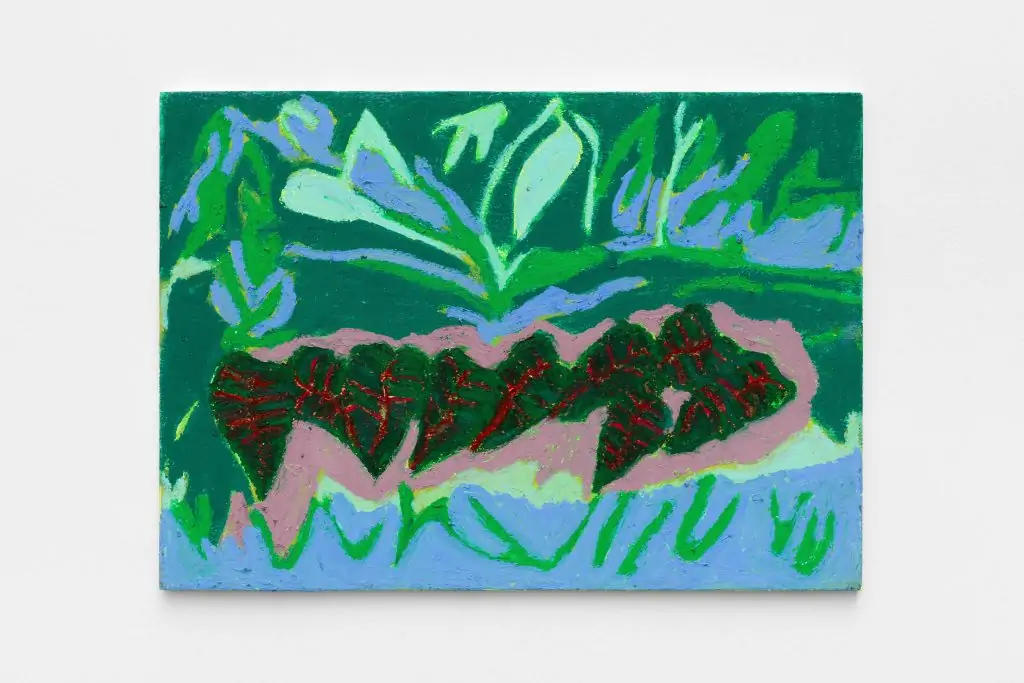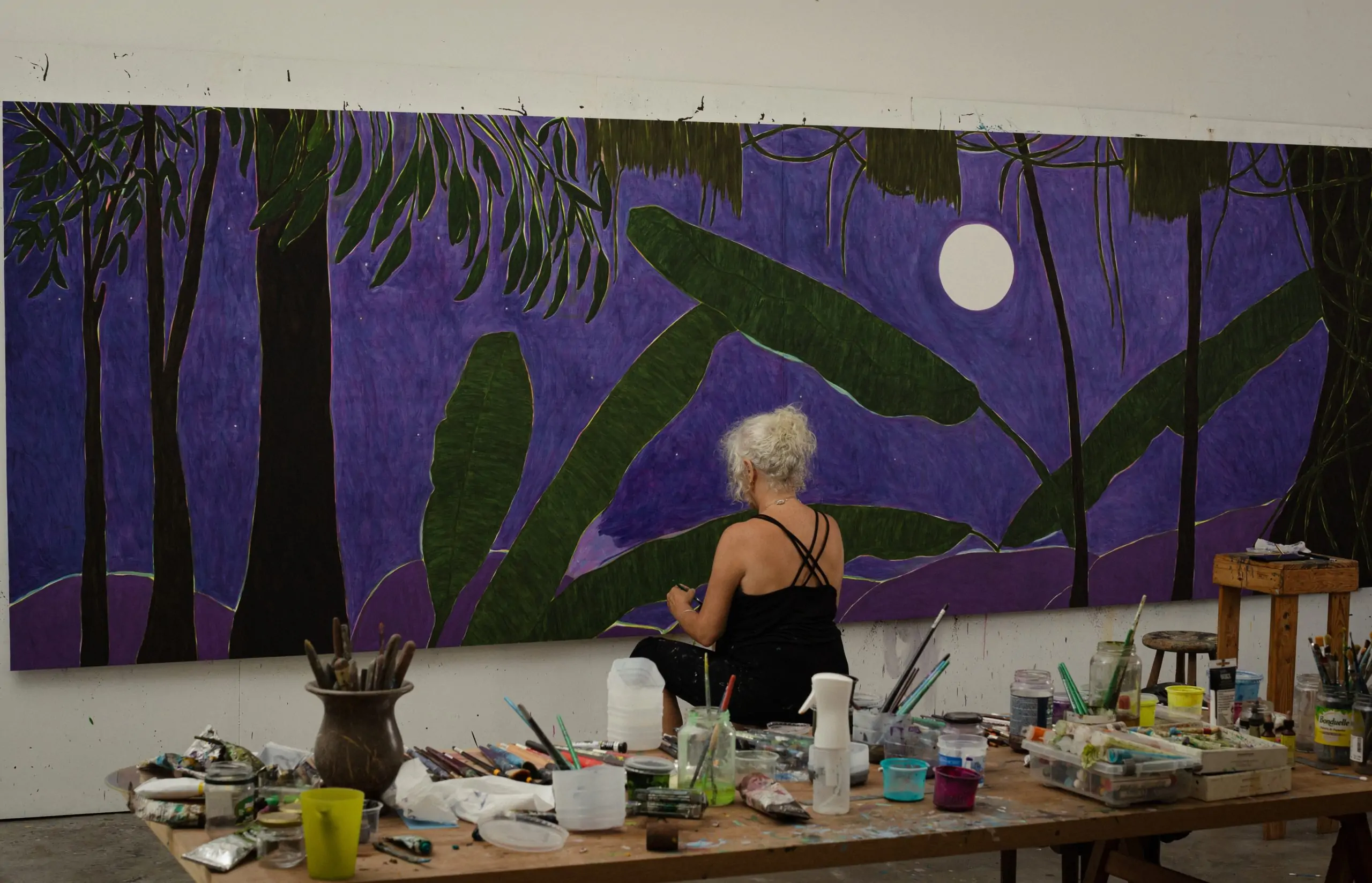Patricia Leite: Paisagem de Lenda
7 June–3 August 2024
Thomas Dane Gallery
3 Duke Street
St James’s
London SW1Y
Like many Brazilian children, Patricia Leite (b.1955, Belo Horizonte, Brazil) was raised on the legends of the Tupi-Guarani indigenous people. These stories are embedded in the landscapes of Brazil, where the gods reside in the sun, the moon, the forest, the sea, the stars and the mountains, transforming these features of the landscape into lead characters to which a young Leite would look to shape her own world and imagination.
For Paisagem de Lenda (Landscape of Legend), her second exhibition at Thomas Dane Gallery in London, Leite presents a group of new paintings and a floor-based tapestry that invoke these indigenous stories, deeply linked to the landscape and ecology of Brazil. As these natural environments are being eroded by climate change, industry, extraction and the destructive policies of neglectful governments, Leite creates work that reflects on what will be lost, and in melancholic celebration of what still remains. Leite’s work is imbued with stories and memories from her life: her recollections of travel and of friendships.

Credit Estudio EmObra
As one is taken through the studio, Leite often refers to each painting in progress, before she has titled them, by the source of the reference image for the work’s starting point, each with an origin story of its own: “the sea, from my son” or “the trees, from my friend.” Her method of using pre-existing images to create her work—sometimes processed, always modified, expanded and elaborated with memory and imagination—means that the image is reassembled on the wooden surface. The result is a strange, artificial quality, completely removed from the source. Curator and writer Rodrigo Moura describes this and the resulting “iconic quality” as one of the defining characteristics of Leite’s work.
Working with São Paolo-based, Uruguayan tapestry maker Jorge Francisco Soto, Leite features the giant lily pads that are a symbol of the Amazon as an intricate floor tapestry, the centrepiece of the exhibition. Mumuru (por Burle Marx) (2024) is shaped like a body of water, and teems with woven lily pads and flowers, inspired by The origin of the Mumuru (Vitoria Regia, or Giant Lily Pad).
In the story a young girl called Naiá becomes captivated by the goddess Jaci, embodied by the moon, as she casts a splendid light over her village. Naiá dreamed of one day becoming a star so she could shine alongside the goddess, eventually being drawn into a lake by the moon’s reflection. The story states: “Jaci, watching from above, was moved by such adoration and rewarded Naià’s sacrifice by transforming her into a star unlike any other that shines in the sky – one that would float on water. Naiá is memorialised to this day as the Mumuru, whose fragrant white flowers are said to only open at night for the goddess Jaci, and blush pink at sunrise like the adoring face of the young girl Naiá.”

Credit Estudio EmObra
The tapestry is overlooked by a huge panoramic nightscape, painted with oil on wood. Leite has an obsessive preoccupation with the moon, a subject she returns to over and over in an attempt to capture the strangeness and ephemerality of night, or the moment the day slips into night: the liminal feeling of the in-between. How to show the depth and immensity of the night sky? How to make a painting that feels like dusk? In the panoramic Jaxi (2024) we see the moon bright against an indigo night sky and we understand she is the painting’s protagonist, illuminating the edges of deep green palm leaves in the foreground, and casting other shapes into shadowy black silhouettes.
The phenomena of light and water, catching their essential qualities, is a recurring preoccupation in Leite’s work: rainfall, sea, reflections, starlight, dusk, moonlight, are all present here. In Glisten (2024) we see a group of trees reflected in a still body of water. In Sideral (para Naiá) (2024), Leite paints a sky full of shooting stars and celestial bodies; and in Toró (2024), cascading heavy rainfall covers the entire picture plane, almost to abstraction.
Vista aérea (2024) shows us a boat sitting languidly amongst mumuru, seen from a birds-eye perspective. A rhythmic oscillation in scale—both in size and subject, zooming in and out from the micro to the macro—prevails throughout the exhibition, travelling from the immensity of the moonlit or starry night sky, to a close-up of a single leaf, painted on wood.

Credit Estudio EmObra
Leite has described being interested in the place where figuration, abstraction and landscape meet, and in “creating a confusion” there, finding freedom in the space between these languages. Though in dialogue with the Brazilian modernist tendencies in which she was trained, she has created a personal synthesis that hovers in the space between abstraction and representation. The works can have a graphic tendency, but they are not flat.
Instead, there is a close study of the materiality of painting: layers of paint and colour create a luminosity and a texture which capture a fleeting moment of change or a particular atmosphere. Building up layers on layers of thin oil paint, over-painting colours on untreated wooden surfaces, tuning and harmonising the colours over time, she creates a kind of liminality through this handling of paint which seems to hum or vibrate with the feeling of a moment.
It is easy to feel a sense of solitude and reflection amongst these always-unpopulated landscapes. Through their luminosity, seductive fields of colour, their nostalgic register, Leite calls us to look more carefully at our natural world, to pay attention to fleeting moments of intangible beauty, to take notice of landscapes that, if we do not, may disappear through our own base neglect, and eventually, too, become the landscapes of legends. Paisagem de Lenda will be accompanied by a Thomas Dane Gallery publication, including a new text by curator José Augusto Ribeiro in English and in Portuguese.
Patricia Leite: Paisagem de Lenda open on the 7th of June until the 3rd of August, 2024 at Thomas Dane Gallery
©2024 Thomas Dane Gallery





